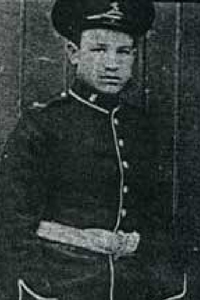13th September 1914
At 4am the Dorsets set out and by 5am had formed up with the rest of the 15th Brigade at Le Mont de Soissons.
Here they were ordered to support the 13th Brigade who had crossed the Aisne and were attacking Missy, about six miles to the north. The brigade marched to Serches, arriving at 8am, and here they waited for most of the day. They has finally reached the southern banks of the Aisne River.
The Germans were defending the heights across the Aisne vigorously, dropping shells with pinpoint accuracy onto the advancing BEF. Most of the bridges across the Aisne had been destroyed as they withdrew. The British found themselves having to repair bridges under fire or improvise other ways of crossing the River Aisne, which was unfordable. The river is at least 15 feet deep in the centre and 170 feet across. Steep-sided spurs rose up from the riverbed up 400 feet to plateaus either side. These plateaus were obscured by dense woods, especially on the northern bank, where the Germans had massed their artillery. The BEF had no way of gauging the enemy’s strength ahead of them. Was this resistance another rearguard or were the Germans standing and fighting?
At 2:30pm the 15th Brigade was moved back about 300ft away from incoming shellfire. Gleichen couldn’t eat his bully beef and biscuits in peace. The Cheshires found a cave, into which they moved their men and horses. I wonder of one of their batmen found it? The rest of the brigade scattered out among the surrounding village.
The Brigade had moved away from a 60lb* battery in front of them, which was attracting considerable interest from German artillery. Gleichen calls the exploding shells “Black Marias”. There’s considerable debate about exactly to what this term refers to. I am going with the more widely held view that it is a generic term for a large German shell, typically fired from a Howitzer between 15 and 21cm calibre, which exploded with a black cloud of smoke. These shells were also referred to as Jack Johnsons (after the famous US Olympic boxer), Woolly Bears** and Coal Boxes. The latter also encompassed the sound they made in the air, like coal falling down a chute.
At 9pm the Dorsets moved out on the final leg of their 15 mile march, towards the river bank. They were heading northwest, towards a place called Moulin Des Roches, in between the bridges at Missy and Venizel. Here, having sloshed through a flood meadow in pitch black, they met the hushed whispers of men from the 59th Field Company, Royal Engineers, led by Captain William Henry Johnston and Lieutenant Robert Bradford Flint. They had built two rafts and were already busily transporting wounded back from the other side. Now they prepared to ferry the 15th Brigade across the Aisne. The Dorsets were sent first, 50 or so men at a time, at about midnight.
* A 5 inch heavy artillery gun, which, according to Gleichen, was also known as a Cow Gun having been drawn by oxen in the Boer War. This can’t have been the case as the BL 60 pounder was only in use from 1904, a full 2 years after the end of the Second Boer War. But you get the picture; this was a big gun with a range of 10,000 yards, or 5.7 miles.
** Woolly bears are, more often than not, used as a specific reference to shrapnel canisters exploding.
